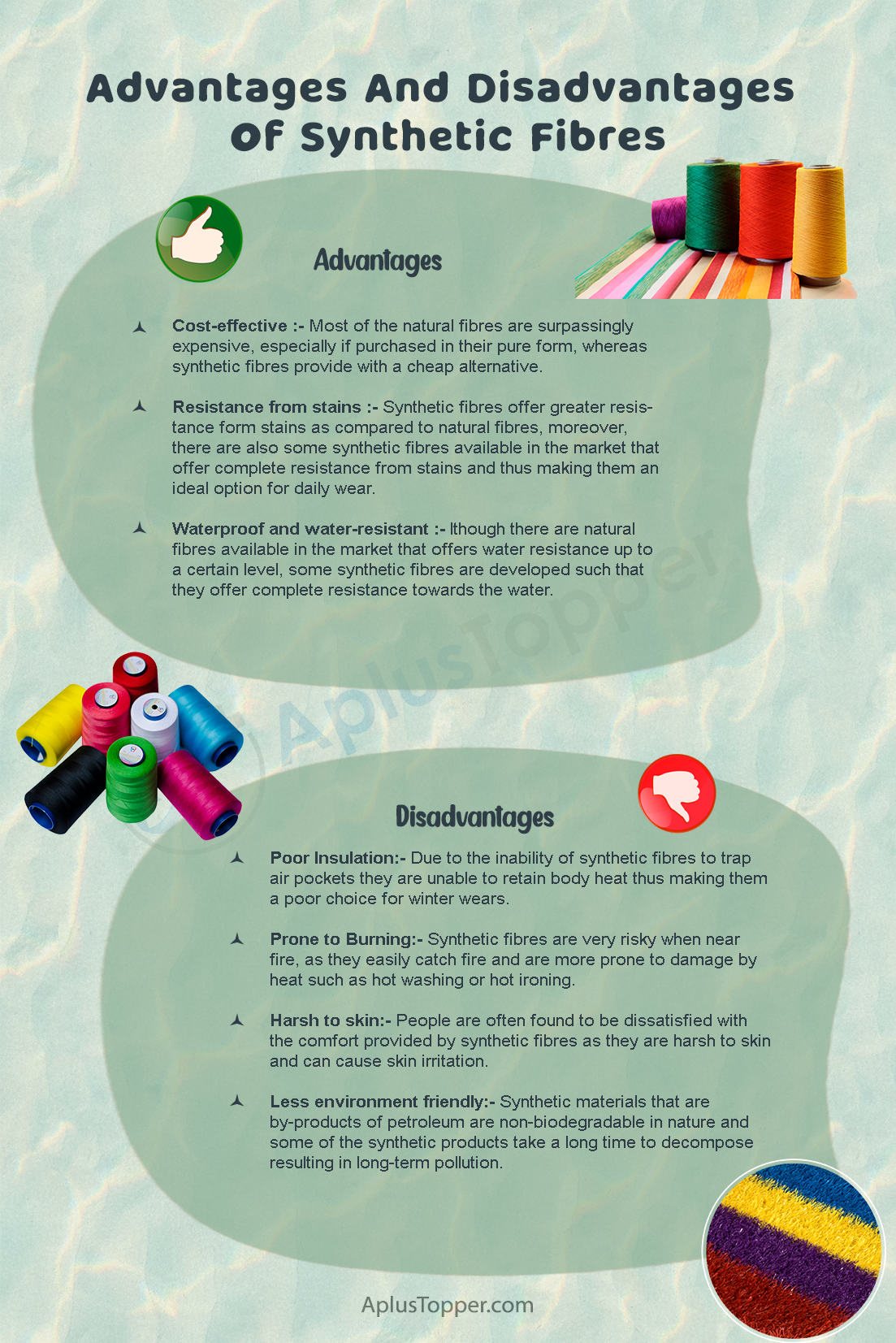Advantages and Disadvantages of Synthetic Fibres: Synthetic fibres are artificial fibres that are obtained through chemical synthesis, in which fibre forming materials are squeezed through spinnerets to create unique fibre. The process involved in creating synthetic fibres is known as polymerization involves monomers to combine and make long chains or polymers. There are two types of polymerizations responsible to manufacture synthetic fibres:
- Cross-linked polymerisation
- Linear polymerisation
Synthetic fibres are derived from compounds such as petrochemicals or petroleum-based chemicals which are then polymerised into chemicals that bond with two adjoining carbon atoms. To produce different types of synthetic fibres, varying chemicals compounds are used.
Students can also find more Advantages and Disadvantages articles on events, persons, sports, technology, and many more.
There are four types of artificial fibres that dominate the market- Polyester, Polyolefin, Nylon, and Acrylic.
Synthetic Fibres are preferred over Natural Fibres as the fabrics made up of artificial fibres are more durable and absorb very less water thus making them able to dry quickly. In addition, these fibres are comparatively more durable than their counterpart i.e., natural fibres, and are less expensive as well. The advent of synthetic fibres revolutionised the fabric industry as they were easier to maintain and were readily available in the market.
- Advantages of Synthetic Fibres
- Disadvantages of Synthetic Fibres
- Comparison Table for Advantages and Disadvantages of Synthetic Fibres
- FAQ’s on Advantages And Disadvantages Of Synthetic Fibres
Advantages of Synthetic Fibres
Synthetic fibres are also known as man-made or artificial fibres and thus have many benefits in daily use fabrics due to their modest price at the same time being able to resist water and stains.
Cost-effective: Most of the natural fibres are surpassingly expensive, especially if purchased in their pure form, whereas synthetic fibres provide with a cheap alternative. These fibres are altogether an interpretation of natural fabrics such as silk and wool.
Resistance from stains: Synthetic fibres offer greater resistance form stains as compared to natural fibres, moreover, there are also some synthetic fibres available in the market that offer complete resistance from stains and thus making them an ideal option for daily wear.
Waterproof and water-resistant: Although there are natural fibres available in the market that offers water resistance up to a certain level, some synthetic fibres are developed such that they offer complete resistance towards the water. These synthetic fibres prove to be an exemplary choice as rain gears and perfect outdoor wear.
Disadvantages of Synthetic Fibres
Although the fabrics made from synthetic fibres are preferred over fabrics that are made of natural fibres, there are many disadvantages to them with most of them being related to their low melting points.
Poor Insulation: Due to the inability of synthetic fibres to trap air pockets they are unable to retain body heat thus making them a poor choice for winter wears. The ability to trap air in natural fibres makes them the best choice as winter fabrics as they provide greater heat insulation.
Prone to Burning: Synthetic fibres are very risky when near fire, as they easily catch fire and are more prone to damage by heat such as hot washing or hot ironing. They should not be subjected to heat beyond a certain level as they tend to melt relatively easily.
Harsh to skin: People are often found to be dissatisfied with the comfort provided by synthetic fibres as they are harsh to skin and can cause skin irritation, this usually happens if the fabric obtained from the synthetic fibre is of low-grade quality.
Less environment friendly: Synthetic materials that are by-products of petroleum are non-biodegradable in nature and some of the synthetic products take a long time to decompose resulting in long-term pollution. Nylon is the best example of such type of fibre as they are hard to decompose and accumulates in landfills and especially the nylon wires used in flying kites are a real menace to animals and birds as they get entangled in them.

Comparison Table for Advantages and Disadvantages of Synthetic Fibres
| Advantages | Disadvantages |
| Synthetic fibres have good elastic properties and can thus be designed to offer stretchable fabrics. | On the other hand, synthetic fibres must be taken care of while subjecting to heat as they tend to melt relatively easier as compared to natural fibres. |
| Synthetic fibres offer wrinkle resistance making them able an ideal fabric material for rough use as they don’t require much ironing and can be used for rough uses as well. | They absorb very little, be it air or water, thus in summers it becomes quite uncomfortable to wear them as sweating may cause it to stick to the skin. |
| They have the ability to withstand heavy loads without breaking and are thus more suitable to prepare materials that are often subjected to carry heavy loads. | Synthetic fibres are more prone to catch fire, thus it is always recommended to be more careful while around the fire as they tend to stick to the skin as it burns, and it becomes quite difficult to extinguish it. |
| Fabrics made from synthetic fibres are cheaper as compared to natural fibres and can be manufactured in a variety of colours. | Synthetic fibres become a mess for people who are prone to skin allergy, thus making it a poor choice for fabrics that are worn close to the skin such as underwear or pajamas. |
| The lightweight characteristic of synthetic fibres makes them the best-suited option to carry while traveling as they are easier to carry, and it takes less space so more clothes can be carried as in case of travelling or for an adventure trip. | They are difficult to sew as the seams do not hold as firmly as in the cases involved while stitching fabrics made from natural fibres. |

FAQ’s on Advantages And Disadvantages Of Synthetic Fibres
Question 1.
How are synthetic fibres made?
Answer:
Synthetic fibres are obtained from small molecules that are synthesised into polymers. The raw materials used to produce artificial fibres are obtained from chemicals that are based on petrochemicals or petroleum.
Question 2.
What are the various uses of synthetic fibres?
Answer:
These fibres have a variety of use in the textile industry as well as they are readily used to manufacture ropes, seat belts and to prepare fishing nets. They are also used to make raincoats, ropes, and caps.
Question 3.
What are the various types of synthetic fibres?
Answer:
There are some readily used synthetic fibres that cover the major section of the market like Polyester, Polyolefin, Nylon, and Acrylic.
Question 4.
What are the characteristics of synthetic fibre?
Answer:
These fibres are more durable, offer higher wear and tear resistance, high lustrous property and the most important is that they offer higher storage options as they do get affected by molds, insects, moths, or mildew.
